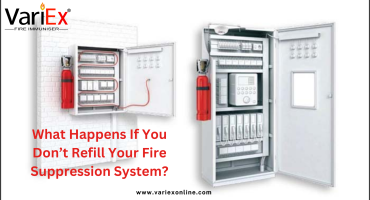![]()
Fire Immuniser
+91-7829629111
Email: info@variex.in
Varistor Technologies Pvt. Ltd.
Block-1, First Floor, Ardente Office One, Hoodi Circle, ITPL Main Road, Bengaluru, Karnataka 560048, IN
The Importance of Regular Maintenance for Firefighting Systems
The Importance of Regular Maintenance for Firefighting Systems
Firefighting systems are a critical component of safety in residential, commercial, and industrial buildings. These systems are designed to detect, suppress, and prevent the spread of fires, saving lives and protecting property. However, even the most advanced firefighting system can fail without proper maintenance. This blog explores the importance of regular maintenance, how it ensures optimal performance, and the steps involved in keeping your firefighting systems in top condition.
Why Regular Maintenance is Crucial
- Ensures System Reliability: Regular maintenance minimizes the risk of system failure during an emergency.
- Compliance with Regulations: Local fire codes often require routine inspections and maintenance.
- Extends System Lifespan: Well-maintained systems last longer and perform better.
- Prevents Costly Repairs: Detecting issues early reduces the likelihood of expensive breakdowns.
- Improves Safety: A maintained system responds faster and more effectively to fires.
Key Components of Firefighting Systems Requiring Maintenance
Firefighting systems consist of multiple components, all of which need regular attention:
| Component | Maintenance Required | Frequency |
|---|---|---|
| Fire Alarms | Check batteries, sensors, and sounders | Monthly/Annually |
| Sprinkler Systems | Inspect pipes, nozzles, and water flow | Quarterly/Annually |
| Fire Extinguishers | Inspect pressure gauge and recharge | Monthly/Annually |
| Fire Hydrants | Test water flow and inspect for damage | Annually |
| Smoke Detectors | Test sensitivity and clean sensors | Monthly/Annually |
| Control Panels | Check for errors or malfunctions | Monthly |
Benefits of Regular Maintenance
1. Enhanced System Performance
Regular checks ensure all components function as intended, improving the system's ability to detect and suppress fires efficiently.
2. Regulatory Compliance
Many jurisdictions have mandatory maintenance requirements. Non-compliance can result in fines or legal liabilities.
3. Financial Savings
Proactive maintenance helps identify and fix small issues before they escalate into major problems, saving on repair and replacement costs.
4. Reduced Downtime
For businesses, a well-maintained system prevents disruptions caused by fire-related incidents or malfunctioning systems.
5. Peace of Mind
Knowing your firefighting system is in optimal condition provides confidence in its ability to protect lives and property.
Common Maintenance Activities
- Visual Inspections
- Look for visible damage, leaks, or signs of wear.
- Ensure components are free of obstructions.
- Functional Testing
- Test fire alarms, smoke detectors, and control panels for responsiveness.
- Activate sprinkler systems to confirm proper water flow.
- Calibration and Adjustments
- Ensure sensors are properly calibrated for accurate detection.
- Adjust system settings based on occupancy or building layout changes.
- Cleaning and Servicing
- Remove dust and debris from sensors and alarms.
- Flush sprinkler pipes and clean nozzles to prevent blockages.
- Repairs and Replacements
- Replace worn-out components like batteries, sensors, or sprinkler heads.
- Repair leaks, electrical issues, or damaged pipes.
Maintenance Checklist for Firefighting Systems
| Task | Frequency | Notes |
|---|---|---|
| Inspect fire alarms | Monthly | Test sound and light indicators. |
| Test sprinkler systems | Quarterly | Check water pressure and flow. |
| Recharge fire extinguishers | Annually or after use | Confirm compliance with standards. |
| Inspect and flush fire hydrants | Annually | Ensure adequate water supply. |
| Clean smoke detectors | Monthly | Remove dust to maintain accuracy. |
| Test control panels | Monthly | Check for error codes or alerts. |
Steps to Implement a Maintenance Plan
- Schedule Routine Inspections
- Create a maintenance calendar based on manufacturer recommendations and legal requirements.
- Engage Certified Professionals
- Hire qualified technicians to conduct inspections, tests, and repairs.
- Document Maintenance Activities
- Maintain detailed records of inspections, repairs, and replacements for compliance purposes.
- Train Your Staff
- Educate your team on identifying issues and understanding system functionality.
- Stay Updated with Regulations
- Keep track of changes in fire safety codes to ensure ongoing compliance.
Signs That Maintenance is Overdue
- False alarms or failure to activate during testing.
- Visible damage to sprinklers, pipes, or fire extinguishers.
- Weak water pressure in hydrants or sprinkler systems.
- Accumulation of dust or debris on detectors and alarms.
- Expired certifications or inspection tags.
Challenges in Firefighting System Maintenance
- Budget Constraints: Allocating funds for regular maintenance can be challenging for some organizations.
- Limited Access: Components in hard-to-reach areas may be neglected.
- Lack of Expertise: Inadequate training can result in poor maintenance practices.
- Negligence: Assuming the system doesn’t need attention until it fails.
How Technology Simplifies Maintenance
- IoT-Enabled Systems
- Real-time monitoring and alerts for maintenance needs.
- Automated Testing
- Systems that perform self-checks reduce manual effort.
- Maintenance Management Software
- Tracks schedules, records activities, and sends reminders for upcoming inspections.
Consequences of Neglecting Maintenance
- Increased Risk of Fire Damage: An unmaintained system may fail during an emergency.
- Regulatory Penalties: Non-compliance can result in fines or closures.
- Higher Repair Costs: Small issues can escalate into major failures.
- Loss of Property Value: Non-functional systems can reduce building resale value.
Conclusion
Regular maintenance is not just a legal requirement but a critical safety measure. It ensures that your firefighting system operates efficiently, prevents costly repairs, and safeguards lives and property. By following a structured maintenance plan, you can enhance the reliability and longevity of your system while staying compliant with fire safety regulations.
Frequently Asked Questions
Firefighting systems should be inspected monthly, quarterly, or annually, depending on the component and local regulations.
Some basic tasks like visual inspections can be done by building staff, but professional servicing is recommended for technical components.
Neglecting maintenance can lead to system failures, increased fire risks, legal penalties, and costly repairs.
Yes, commercial systems typically require more frequent and thorough maintenance due to stricter compliance standards.
Look for licensed fire safety companies with experience in maintaining systems similar to yours.
Final Say
At VariEx.in and VariexOnline.com, we specialize in supplying and installing top-quality fire fighting systems and equipment. From fire extinguishers to advanced suppression systems, we offer comprehensive solutions tailored to your needs. Our experienced team ensures precise installation and maintenance for optimal safety.
Trust VariEx for reliable fire protection. Contact us online or call 7829629111 to learn more.
We specialize in manufacturing, supplying, and distributing a comprehensive range of fire fighting equipment, including state-of-the-art fire extinguishers. Read our most searched blogs and find interesting information on topics such as how to use a fire extinguisher, how to calculate fire fighting water tank capacity, fire extinguisher refilling, obtaining a Fire NOC, understanding fire fighting systems, types of fire protection systems, the fire hydrant system, and the fire sprinkler system. These resources provide essential knowledge for ensuring safety and compliance with fire safety regulations. Additionally, you can explore guides on the maintenance of fire protection equipment, the latest advancements in fire safety technology, and best practices for fire risk assessment and management.
Our expertise extends to fire alarm systems, fire hydrant systems, and fire suppression systems, including fire sprinklers. Each product meets rigorous international standards for reliability and performance, ensuring effective fire safety products tailored to diverse applications and industries. Additionally, we are providing Fire Extinguisher Refilling and AMC services to ensure ongoing maintenance and operational readiness of fire safety equipment.
"WHAT YOU CAN READ NEXT"
 Read more +24 November 2023 in Fire Extinguisher
Read more +24 November 2023 in Fire ExtinguisherWhat types of fire extinguishers are available for different fire classes?
 Read more +11 April 2025 in Fire Suppression
Read more +11 April 2025 in Fire Suppression






